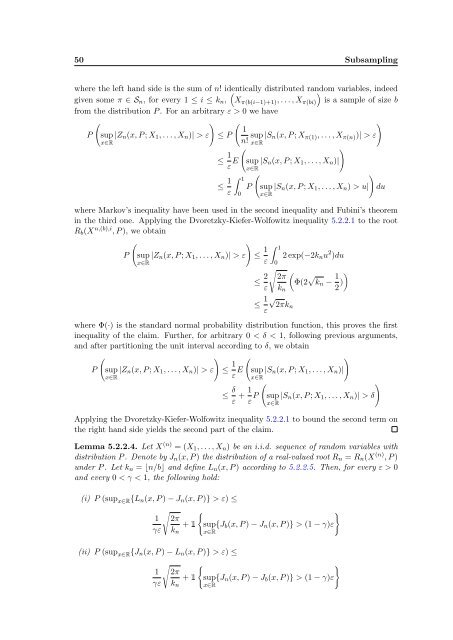Subsampling estimates of the Lasso distribution.
Subsampling estimates of the Lasso distribution.
Subsampling estimates of the Lasso distribution.
Create successful ePaper yourself
Turn your PDF publications into a flip-book with our unique Google optimized e-Paper software.
50 <strong>Subsampling</strong><br />
where <strong>the</strong> left hand side is <strong>the</strong> sum <strong>of</strong> n! identically distributed random ) variables, indeed<br />
given some π ∈ S n , for every 1 ≤ i ≤ k n ,<br />
(X π(b(i−1)+1) , . . . , X π(bi) is a sample <strong>of</strong> size b<br />
from <strong>the</strong> <strong>distribution</strong> P . For an arbitrary ε > 0 we have<br />
(<br />
)<br />
)<br />
P<br />
sup |Z n (x, P ; X 1 , . . . , X n )| > ε<br />
x∈R<br />
(<br />
1<br />
≤ P<br />
n! sup |S n (x, P ; X π(1) , . . . , X π(n) )| > ε<br />
x∈R<br />
)<br />
≤ 1 (sup<br />
ε E |S n (x, P ; X 1 , . . . , X n )|<br />
≤ 1 ε<br />
x∈R<br />
∫ ( 1<br />
0<br />
P<br />
sup |S n (x, P ; X 1 , . . . , X n ) > u|<br />
x∈R<br />
where Markov’s inequality have been used in <strong>the</strong> second inequality and Fubini’s <strong>the</strong>orem<br />
in <strong>the</strong> third one. Applying <strong>the</strong> Dvoretzky-Kiefer-Wolfowitz inequality 5.2.2.1 to <strong>the</strong> root<br />
R b (X n,(b),i , P ), we obtain<br />
P<br />
(<br />
sup |Z n (x, P ; X 1 , . . . , X n )| > ε<br />
x∈R<br />
)<br />
≤ 1 ε<br />
≤ 2 ε<br />
∫ 1<br />
0<br />
2 exp(−2k n u 2 )du<br />
√<br />
2π<br />
k n<br />
(<br />
Φ(2 √ k n − 1 2 ) )<br />
≤ 1 ε<br />
√<br />
2πkn<br />
where Φ(·) is <strong>the</strong> standard normal probability <strong>distribution</strong> function, this proves <strong>the</strong> first<br />
inequality <strong>of</strong> <strong>the</strong> claim. Fur<strong>the</strong>r, for arbitrary 0 < δ < 1, following previous arguments,<br />
and after partitioning <strong>the</strong> unit interval according to δ, we obtain<br />
(<br />
)<br />
≤ 1 (<br />
)<br />
ε E<br />
P<br />
sup |Z n (x, P ; X 1 , . . . , X n )| > ε<br />
x∈R<br />
sup |S n (x, P ; X 1 , . . . , X n )|<br />
x∈R<br />
≤ δ ε + 1 (sup<br />
ε P |S n (x, P ; X 1 , . . . , X n )| > δ<br />
x∈R<br />
Applying <strong>the</strong> Dvoretzky-Kiefer-Wolfowitz inequality 5.2.2.1 to bound <strong>the</strong> second term on<br />
<strong>the</strong> right hand side yields <strong>the</strong> second part <strong>of</strong> <strong>the</strong> claim.<br />
Lemma 5.2.2.4. Let X (n) = (X 1 , . . . , X n ) be an i.i.d. sequence <strong>of</strong> random variables with<br />
<strong>distribution</strong> P . Denote by J n (x, P ) <strong>the</strong> <strong>distribution</strong> <strong>of</strong> a real-valued root R n = R n (X (n) , P )<br />
under P . Let k n = ⌊n/b⌋ and define L n (x, P ) according to 5.2.2.5. Then, for every ε > 0<br />
and every 0 < γ < 1, <strong>the</strong> following hold:<br />
(i) P (sup x∈R {L n (x, P ) − J n (x, P )} > ε) ≤<br />
√ {<br />
}<br />
1 2π<br />
+ 1 sup{J b (x, P ) − J n (x, P )} > (1 − γ)ε<br />
γε k n x∈R<br />
(ii) P (sup x∈R {J n (x, P ) − L n (x, P )} > ε) ≤<br />
√ {<br />
}<br />
1 2π<br />
+ 1 sup{J n (x, P ) − J b (x, P )} > (1 − γ)ε<br />
γε k n x∈R<br />
)<br />
du<br />
)
















